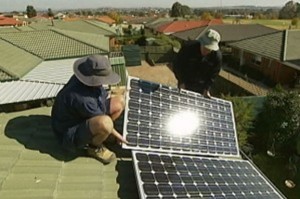
Well, to answer the above question, we must first need to understand a few important things:
1. Majority of the space is required to install solar panels. So when we use the term “solar system installation” we mean solar panel installation. Alongside the solar panels other equipment that need to be installed are inverter, meter, battery placed in shed or in a room too.
2. The “Place” where solar panels can be installed could be ground, rooftop, window, shed etc.
To maximize efficiency, solar modules should be installed at a location where they will receive the maximum amount of sunlight throughout the year. For a typical 1 KW system requires 100 sq. ft area. A solar installation team has to analyse the dimensions of the shade free area of the roof, shed, or ground. First its important to know what is solar PV cell and solar module.
What is a Solar PV Cell and Solar Module?
Solar PV cell is basic building block of a PV system that consists of semiconductor material that absorbs sunlight to generate electricity via a process called “photoelectric effect” where sunlight at a certain wavelength effectively generates power. Though solar PV can generate power on a cloudy day, but not as effective as on sunny day. A basic PV cell generates small amount of electricity and multiple PV cells connected together form solar PV module that generates upto 10W to 300W power. If more power is needed, then a number of PV modules have to be installed. A variety of materials are used to manufacture a solar PV cell and its efficiency depends on the same. Efficiency of a solar cell depends on the PV cells capability to convert sunlight into power that varies from 4% to 16%. It must be kept in mind that dimensions of a solar PV module depend on output and efficiency.
Dimension Analysis
In the Northern Hemisphere solar modules should face the south, while in the Southern Hemisphere modules should face the north. As, India lies in Northern Hemisphere, solar panels have to be mounted facing towards south with required tilting based upon the geographical location.
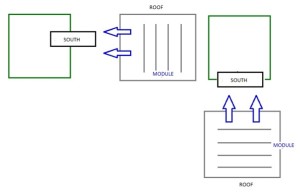
To Design a Solar Panel System, it is Mandatory to Calculate Exact Roof Dimensions
- All dimensions – all sides of the roof.
- Shading is by far the most common factor which can affect solar PV output. If there is any structure like tank/room/neighbouring wall that can affect the available area have to be properly measured.
Based on the above dimension analysis, if you have empty shade-free roof or a shed facing south or empty ground, you can install solar rooftop system anywhere at your home or office. What size of solar power installation should you go for? Following re points one needs to ponder over before selecting solar PV panel as well as a solar EPC contractor. Read on:
1. Look at Your Energy Bill
As always the best place to start is by looking at your recent energy bills. An energy efficient 3 bedroom home, with an average size family and reasonable use of air conditioner usually has average daily consumption of about 12 kWh to 16kWh. Depending on how much daylight you receive on average per day, a 1kW solar power system will usually produce around 4kWh to 5kWh of energy per day.
2. Estimate How Much Electricity is Used During Daytime
Important to remember that unless there is battery storage, the solar panels meet your electricity needs during the daytime hours only. The electricity from your solar panels flows first into any home appliances in use within your home at the time, saving you the money spent to buy electricity from your electricity retailer (usually at a rate of 20-30c/kWh). Any surplus electricity generated using solar panels goes back into the electricity grid. This means that you want solar panels that generate that much electricity that helps you to meet your daytime electricity usage. As such estimating the total electricity consumption when the sun is shining is important. So if on an average a household’s daily electricity demand is 20kWh with around 33% occurring during daylight hours, a 2kW solar photovoltaic system is ideal. This PV system can generate enough amount of solar power to offset your daytime energy usage requirement without wasting too much solar power by exporting it back into the power grid.
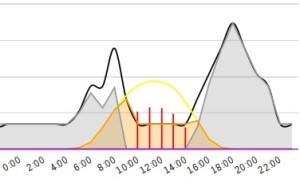
‘Double Hump’ electricity usage pattern is common in homes with school-age children. The highest electricity consumption happening outside peak solar production times, the trough in middle of graph. Red bars represent ‘wasted’ solar going ack into the electricity grid.
A 3kW PV system, on the other hand, would be slightly large for your home if there is not much use of electricity during the day, exporting nearly 50% of the electricity produced on average. However, if you are at home during the day it would make a good fit, with only 30% of electricity generated going back to the grid on average.
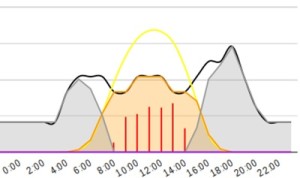
‘Day Focus’ electricity usage pattern is common in homes occupied by retirees or those working from home. With an ideal solar power system, such homes can easily use large chunk of solar energy produced, sending only a small amount back into the electricity grid.
3. Consider Whether Battery Storage is Good for You
Not all solar PV systems come with battery storage systems, which is mostly sold separately or fitted onto an existing solar PV systems retroactively. If you want a battery storage system, a number of things need to be considered. Things like whether you want to go ‘off the grid’ or just want to save electricity by using solar energy at night time must be given a thought. First you have identity area to install, next comes the system size requirement and type of system. There are different types of systems that can installed at your place – with or without battery, different capacity, grid connected or stand-alone. As per this example, to generate 2000 watts from a 12% efficient system, you need a 200 sq.ft of roof area.
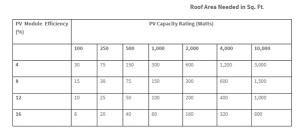
4. Sizing a Solar Power System
Before you buy a solar power system, its’ important to size up your load requirement in your setup. It is important to note that a solar power system is good for operating low watt electrical appliances such as lights, TV, fans, etc. High wattage appliances such as air conditioner, water heater cant be operated using solar PV system (however solar water heaters and solar air conditioners are separately available). Its’ important to make sure that your solar PV system whether it is a grid-connected or stands alone (off-grid) system and is energy efficient; as the connected load of your solar power setup determines the size of system that you need to install on your rooftop at office or home as that in turn drives the cost of solar power system.
5. Where to Install a Solar Power System
Usually, solar PV panels at homes are mounted on rooftop, but they can be installed on the ground, car parks, corridors, or even near to boundary walls. Depending on conditions and setting of property, as also amount of power needed, any of the positions can provide the requisite amount of sunlight. Factors that determine positioning and orientation of solar panels includes the direction of roof and/or property is facing, angle or tilt of roof, weather conditions including rain, hailstorm, snowfall that hits the area in a year.
The reason rooftop is popular for solar PV positioning is because it tends to receive the maximum sunlight. In case rooftop mounted solar panels arent practical due to limitation in space better to go for ground-mounted system if enough open area is available. Sometimes unexpected shading throughout the day can have a huge impact on how much solar energy is getting converted into power. Just because your property doesn’t have any big tree, doesn’t mean the neighbourhood palm tree can’t shadow your home. As such solar panel installation should also take into considerations these neighbourhood issues.
6. Other Considerations for Installing a Solar PV System
It is very important to assess the amount of direct or scattered sunlight available at the location where a solar PV system is to be installed. In order to collect the maximum amount of sunlight the ideal orientation of a Solar Panel is towards south (n case of India). However a 45-degree deviation towards the southeast or the southwest also works with a condition that there should be no obstruction due to trees or adjoining buildings resulting in shading.
In case these requirements arent fulfilled, better consult an expert for a detailed analysis of amount of sunlight available for the solar PV system installed at home or office. Another issue is the capacity of the roof to take the load of solar panel structures that typically weigh around 15kg per sq. mtr. The tilt at which solar PV panel is to be installed is also important, it should be same as the latitude of home or office.
7. Electricity Generated from a Solar PV System
Although we talked about wattage capacity of solar PV system, but it doesnt mean the wattage will be available 24/7/365. The unit or kW output of solar PV panel depends on the efficiency of solar PV panels as well as availability of continuous sunlight. Factor that defines the output is CUF (or Capacity Utility Factor). In India, its typically 19% and calculation of power units goes as:
Units Generated Annually (in Kwh) = System Size in Kw * CUF * 365 * 24
So a 1kW capacity solar PV system will generate 1600-1700 kWH of electricity / year (note: its just a thumb rule & the CUF may vary in across India).
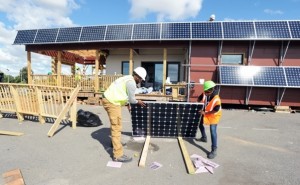
8. Components of a Rooftop PV System
A typical Rooftop PV system contains batteries, inverter and Solar PV modules. The efficiency of the solar PV system also depends on type of battery and inverter used. Sealed maintenance free or tubular lead-acid batteries that last anywhere between 5-10 yrs with efficiency of nearly 80% are best suited for use with solar PV system. These batteries are designed to provide electricity over long period of time and are capable of discharging upto 80% of their capacity repeatedly. Automotive batteries with shallow cycle are avoidable. It is important to size up the batteries so that they are capable of storing sufficient power for use during cloudy weather. Also important to know that these batteries must be kept at location that is easily accessible, ventilated, protected from vagaries of extreme weather conditions.
It is also important to choose the right kind of inverter, ideally it is a modified pure sine wave inverter that is at least 85% efficient and is best suited for use with solar PV installations; but are bit expensive, but are good for use all kinds of solar PV appliances.
9. Warranties and Maintenance Requirements of a Solar PV System
If a Solar PV module is purchased under National Solar Mission then it comes with a warranty of 25 years from the date of supply. A solar home lighting system (along with an inverter) comes with warranty of 5 yrs and sealed maintenance free batteries come with 2 yrs warranty and lead acid flooded type battery come with 5 yr warranty. Solar PV module makers on their part should use English and a local language to write manual of instructions for operation and maintenance of the system. Just like electrical and mechanical systems, a long lasting solar PV system requires regular maintenance. Cleaning a solar PV system of dust and bird droppings on regular basis helps maintain its efficiency. A sealed maintenance free battery doesnt need regular maintenance. Just making sure that the solar PV system gets adequate sunlight is enough.


10. Solar Panel Inverters vs. Micro Inverters
The solar panels must be fed into solar panel inverters using equal sized PV arrays. A normal solar inverter uses a string of PV panels to produce power, even though all the PV panels are not expected to generate the same amount of power at the same time. One array might be making 99 watts while another 105 watt. But since they are in a single string, the solar inverter basically takes into account the lowest panels output meaning those panels/arrays producing more wattage go waste all the time. Also, even if a single PV panel/array stops functioning, the entire string of array stops producing power altogether. While it may not affect the output in a solar farm but will affect output of a home with rooftop or ground mounted solar panel/array. So what to do?
11. How Solar Micro Inverters Work
The answer to this efficiency problem could be micro inverters. Instead of stringing multiple PV panels/array together and putting them through one big solar inverter, micro-inverters are small and can be installed on every single solar panel/array. This allows each PV panel to produce 100% of its production capacity, even if one array fails it doesn’t affect the output of other panels/arrays.
12. Choose between Solar Inverters and Micro Inverters
Both solar inverters and micro inverters have their own benefits; while micro-inverters are more efficient, they are expensive and require a lot more wiring. Big solar inverters might be heavy, but they can be mounted in one spot and with minimal wiring. They are also extremely reliable.
13. Cost of Solar PV Module and Incentive from MNRE
The cost of a PV module costs anywhere between Rs 30 to Rs 50 / watt of power generated. An imported solar PV module costs around Rs 40 / watt. Those made in India cost around Rs 30-32 / watt. This is the cost of the solar panel and inverter and battery cost are additional. A good 5 kW solar PV system for a home costs about Rs 3-4 lakhs to setup, providing electricity for average up to 25 years.
14. Select a Solar EPC Contractor After Asking Following Questions
Q 1. Has the solar EPC company installed any grid-connected or stand-alone PV systems?
A 1. Experience to install grid-connected system for a Solar EPC contractor is important as there are some elements related to installation such as interconnectivity with local electricity grid which is unique to these systems. However, a company experienced in off-grid solar PV system should not be written off the list just because it has not installed any grid-connected PV systems. Experience with off-grid PV systems is also important as grid-independent systems are technically more complex than grid-connected systems.
Q2. How much experience solar EPC company need to install solar PV systems?
A2. An experienced EPC contractor who has installed grid connected and/or off-grid solar PV systems understands how to compete with other EPC firms. The contractor must be aware of the latest trends, laws, codes and permissions required to install solar PV system.
Q3 Does the company need requisite licenses or certifications?
A3. Grid connected or off-grid solar PV systems must be installed only by a licensed solar EPC contractor. This means that either of the installer or the subcontractor must have electrical contractor’s license. The state electricity board can provide information on whether an EPC contractor has all the valid electrician’s licenses. The local building department can provide info if the EPC installer has general contractor’s license. A solar rebate program run by central and/or state government may require that a solar EPC contractor apart from being licensed is capable enough to demonstrate its special knowledge about installation of solar PV systems that includes various certifications/approval/permissions issued by solar industry and/or trade associations.
Q4. Does the company have any pending or active judgments against it?
A4. It is important that a solar EPC contractor as with any other project must go through the due diligence process. The local office of electricity board can provide all the relevant information regarding any judgment or complaint against a state-licensed solar EPC contractor. End users can ask city administration where they live to get information on any EPC contractor. It is always good to have multiple bids from various EPC contractors for installation of a Solar PV system. End users need to make sure that all the bids by the contractors are made on the basis of requirement only so as to not mix up between ground mounted and rooftop system.
15. Lease or Buy Solar PV System?
Every household needs to run its own cost-benefit analysis on whether to buy or lease a solar PV system. Buying your own solar PV system costs more upfront but pays big dividend in the long run; leasing solar PV system lets you enjoy cheap electricity with little or no money down, but benefits are limited. If you lease solar PV system, the company you contract with owns the system, and you are obliged to pay them a certain rate for the electricity; when the lease period is over, the company may take back the solar PV system. However when you buy a solar PV system, it keeps working for your benefit long after the investment is recovered. Be sure to compare the total lifecycle cost of the solar PV system lease and weigh the savings against the benefits when you go for solar PV system ownership.
While doing the financial analysis, do keep in mind that the solar PV system can function for decades but other electrical/electronic equipment like power inverter, wires have a much shorter lifespan. Factor the replacement cost for components when budgeting for the projected requirement for solar PV system.
16. So What Should You See When Signing Your Solar PV System Contract?
The contract for solar PV system you sign should spell out all the details with respect to ownership, finance, and performance parameters. As the solar PV system can include web-enabled devices, you need to double check if anyone other than you or those authorized is access to collect the data on your home energy production via solar PV system.
All in all installing a solar PV system at home or office be it a rooftop or ground mounted system has a lot of variables that need to be considered before setting it up for long term benefits. So it is important to contact a reliable solar PV system integrator/contractor to garner the maximum benefits.
About Vivaan Solar
Vivaan Solar as a EPC contractor is a solar PhotoVoltaic system installer & integrator. We have installed 60 MW solar park in Madhya Pradesh, 5 MW in Punjab, 8 MW in Uttarakhand and an upcoming park in Karnataka. We are also MNRE accredited channel partner for Rooftop. We have done turnkey works for multiple companies across the country and has third party agreements with some of the leading industries/commercial institutions across the state.
Sources
http://www.solarchoice.net.au/blog/what-size-solar-power-installation-should-you-buy/
https://www.bijlibachao.com/solar/roof-top-solar-pv-system-project-for-home-and-office.html
https://www.thesolarco.com/where-is-the-best-place-to-install-my-solar-panels/\
http://geekbeat.tv/the-complete-guide-to-installing-a-pv-photovoltaic-solar-panel-system/
http://www.citylab.com/navigator/2016/04/want-solar-panels-on-your-roof-heres-what-you-need-to-know/476805/

XR
I’ve been surfing online more than three hours today, yet I
never found any interesting article like yours.
It is pretty worth enough for me. In my view, if all
webmasters and bloggers made good content as you did, the
web will be much more useful than ever before.
dear
sir/madam
Thanks for the appreciation for writing the blog and do spread the word about our blog.
We do like to share useful information on solar power
and renewable energy and technology and add our perspective and please share the info with your friends.
Keep watching this space for the latest blog updates and do watch our social media details.
Nice article..!!
dear
sir/madam
Thanks for the appreciation for writing the blog and do spread the word about our blog.
We do like to share useful information on solar power and renewable energy and technology and add our perspective and please share the info with your friends.
Keep watching this space for the latest blog updates and do watch our social media profile.
Pretty! This has been a really wonderful article. Thanks
for supplying this info.
dear
sir/madam
Thanks for the appreciation for writing the blog and do spread the word about our blog.
We do like to share useful information on solar power and renewable energy and technology and add our perspective and please share the info with your friends.
Keep watching this space for the latest blog updates and do watch our social media profile.